Class 11 Maths Ncert Solutions Chapter 1 Exercise 1.3
NCERT Solutions for Class 11 Maths Chapter 1 Sets Ex 1.3
Get Free NCERT Solutions for Class 11 Maths Chapter 1 Sets Ex 1.3 PDF in Hindi and English Medium. Sets Class 11 Maths NCERT Solutions are extremely helpful while doing your homework. Sets Exercise 1.3 Class 11 Maths NCERT Solutions were prepared by Experienced LearnCBSE.in Teachers. Detailed answers of all the questions in Chapter 1 Class 11 Sets Ex 1.3 provided in NCERT Textbook.
- Class 11 Sets Ex 1.1
- Class 11 Sets Ex 1.1 in Hindi Medium
- Class 11 Sets Ex 1.2
- Class 11 Sets Ex 1.2 Hindi Medium
- Class 11 Sets Ex 1.3
- Class 11 Sets Ex 1.3 Hindi Medium
- Class 11 Sets Ex 1.4
- Class 11 Sets Ex 1.4 Hindi Medium
- Class 11 Sets Ex 1.5
- Class 11 Sets Ex 1.5 Hindi Medium
- Class 11 Sets Ex 1.6
- Class 11 Sets Ex 1.6 Hindi Medium
- Class 11 Sets Miscellaneous Exercise
- Class 11 Sets Miscellaneous Exercise in Hindi Medium
- Sets Class 11 Notes Maths Chapter 1
- NCERT Exemplar Class 11 Maths Chapter 1 Sets
- RD Sharma Class 11 Solutions Chapter 1 Sets
- Chapter 1: Sets Class 11 NCERT Book
- अध्याय 1: समुच्चय Class 11 NCERT Book
Free download NCERT Solutions for Class 11 Maths Chapter 1 Sets Ex 1.3 PDF in Hindi Medium as well as in English Medium for CBSE, Uttarakhand, Bihar, MP Board, Gujarat Board, BIE, Intermediate and UP Board students, who are using NCERT Books based on updated CBSE Syllabus for the session 2019-20.
Class 11 Maths NCERT Solutions Chapter 1 Sets Ex 1.3
Q.1: Fill in the blanks properly using ⊂ and ⊄ .
(i). {3, 4, 5} ____ {2, 3, 4, 5, 6}
(ii). {a, b, c} ____ {d, c, d}
(iii). {y: y is a pupil of Class 11 of the school} ____ {y: y is students of the school}
(iv). {y: y is a circle in the plane} ____ {y: y is a circle in the same plane with radius 2 unit}
(v). {y: y is an equilateral triangle in a plane} ____ {y: y is a rectangle in the same plane}
(vi). {y: y is an equilateral triangle in a plane} ____ {y: y is a triangle in the plane}
(vii). {y: y is an odd natural number} ____ {x: x is an integers}
Solution:
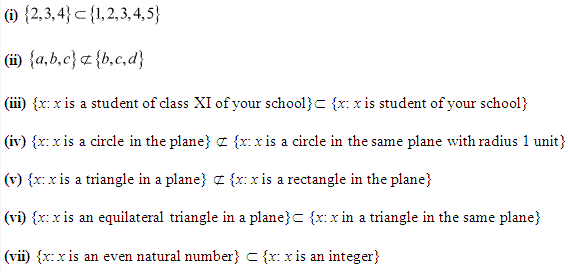
Q.2: State whether the given statements are true or false:
(i). {b, c} ⊄ {c, d, e}
(ii). {a, e, i} ⊂ {x: x is a vowel in the English alphabets}
(iii). {1, 2, 3} ⊂ {1, 2, 4, 5}
(iv). {c} ⊂ {b, c, d}
(v). {b} ∈ {a, b, c, d}
(vi). {y: y is an even natural no. less than 6} ⊂ {y: y is a natural no. which can divide 36}
Solution:
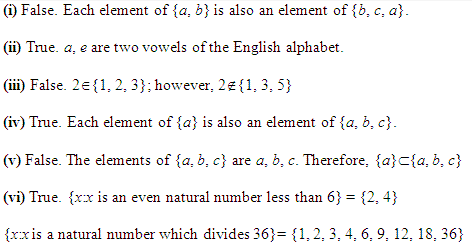
Q.3: Let X = {11, 12, {13, 14}, 15}. According to the given set which of the given statements are false? Explain why.
(i). {13, 14} ⊂ X
(ii). {13, 14} ∈ X
(iii). {{13, 14}} ⊂ X
(iv). 11 ∈ X
(v). 11 ⊂ X
(vi). {11, 12, 15} ⊂ X
(vii). {11, 12, 15} ∈ X
(viii). {11, 12, 13} ⊂ X
(ix). Ø ∈ X
(x). Ø ⊂ X
(xi). {Ø} ⊂ X
S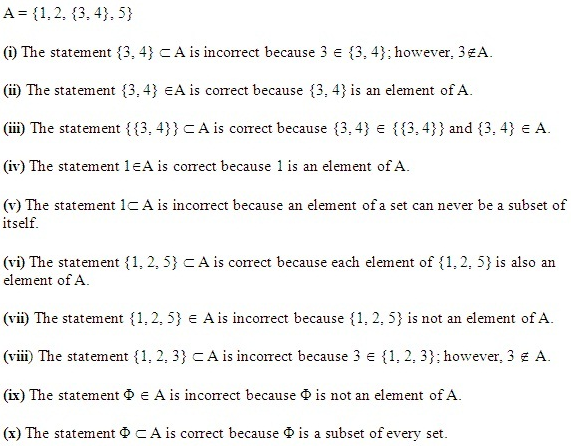

Q.4: Write all the subsets of the given sets:
(i). {b}
(ii). {b, c}
(iii). {2, 3, 4}
(iv). Ø
Solution:
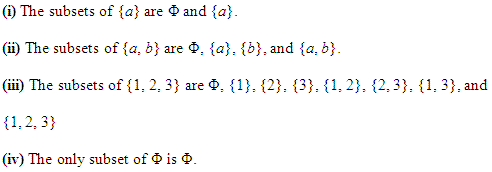
Q.5: How many elements has P(X), if X = Ø ?
Solution:

Q.6: Write the given in the form of intervals:
(i). {y: y ∈ R, –5 < y ≤ 7}
(ii). {y: y ∈ R, –13 < y < –11}
(iii). {y: y ∈ R, 1 ≤ y < 8}
(iv). {y: y ∈ R, 4 ≤ y ≤ 5}
Solution:
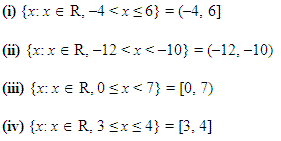
Q.7: Write the given intervals in the form of set – builder:
(i). (–4, 1)
(ii). [7, 13]
(iii). (7, 13]
(iv). [–24, 6)
Solution:
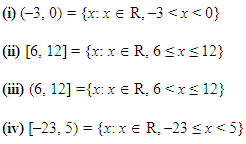
Q.8: What universal set/ sets would you propose for the given sets?
(i). The set of right triangles
(ii). The set of isosceles triangles
Solution:

Q.9: X = {1, 3, 5}, Y = {2, 4, 6} and Z = {0, 2, 4, 6, 8}
Which of the given sets can be considered as the universal set for the given sets X, Y and Z?
(i). {0, 1, 2, 3, 4, 5, 6}
(ii). Ø
(iii). {0, 1, 2, 3, 4, 5, 6, 7, 8, 9, 10}
(iv). {1, 2, 3, 4, 5, 6, 7, 8}
Solution:
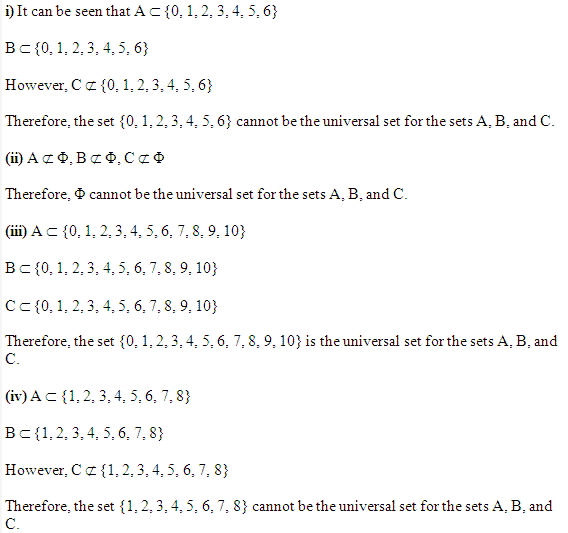
NCERT Solutions for Class 11 Maths Chapter 1 Sets Ex 1.3 in Hindi
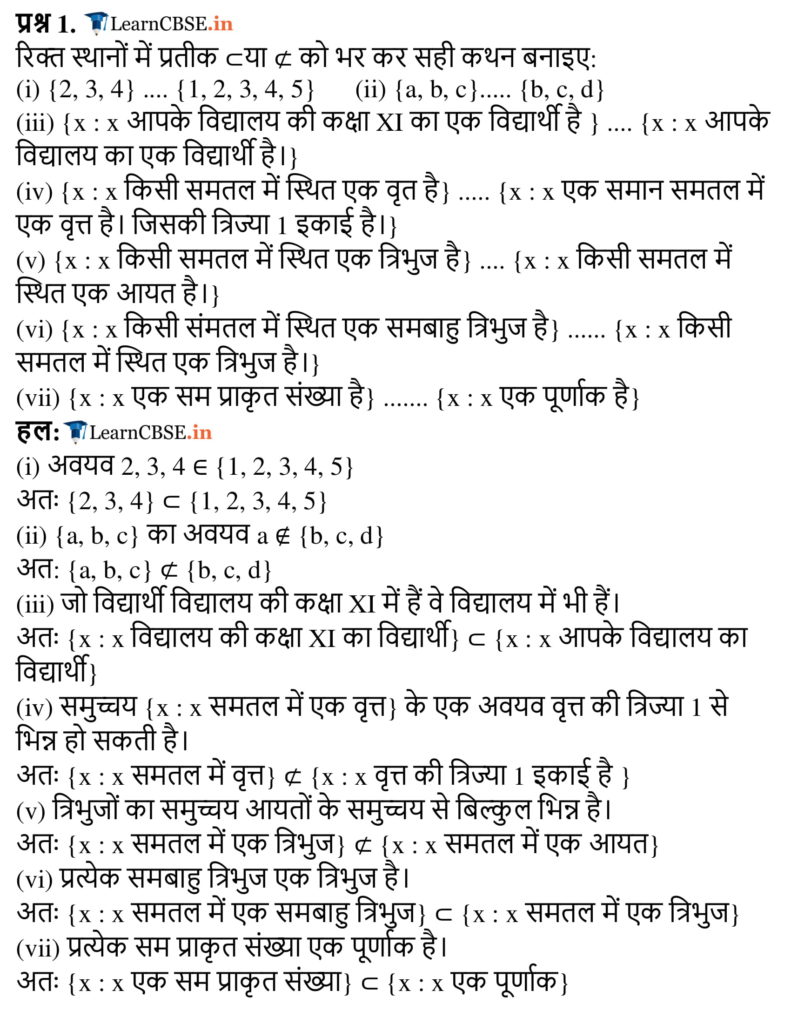
प्रश्न 2.
जाँचिए कि निम्नलिखित कथन सत्य हैं अथवा असत्य हैं:
(i) {a, b} ⊄ {b, c, a}
(ii) {a, e} ⊂ {x : x अंग्रेजी वर्णमाला का एक स्वर है।
(iii) {1, 2, 3} ⊂ {1, 3, 5}
(iv) {a} ⊂ {a, b, c}
(v) {a} ⊂ {a, b, c}
(vi) {x : x संख्या 6 से कम एक सम प्राकृत संख्या है। ⊂ {x : x एक प्राकृत संख्या है, जो संख्या 36 को विभाजित करती है।
हल:
(i) समुच्चय {a, b} के अवयव a, b दासमुच्चय {b, c, a} में है।
{a, b} ⊄ {b, c, a}
अतः उपरोक्त कथन असत्य है।
(ii) a, e दोनों ही स्वर हैं।
{a, e} = {x : x, अंग्रेजी वर्णमाला का एक स्वर है।
अतः यह कथन सत्य है।
(iii) समुच्चय {1, 2, 3} और {1, 3, 5} में अवयव 2 समुच्चय {1, 3, 5} नहीं है।
{1, 2, 3} ⊂ {1, 3, 5} कथने असत्य है।
(iv) a ∈ {a, b, c}
{a} ⊂ {a, b, c} यह कथन सत्य है।
(v) {4} समुच्चय है, अवयव नही है।
{a} } ∈ {a, b, c} कथन असत्य है।
(vi) सम प्राकृत संख्या 2, 4 संख्या 6 से कम है तथा 36 को विभाजित करती है।
{x : x एक सम प्राकृत संख्या है जो 6 से कम है} ⊂ {x : x एक सम प्राकृत संख्या 36 को विभाजित करती है। अतः यह कथन सत्य है।}
प्रश्न 3.
मान लीजिए कि A = {1, 2, 3, 4, 5}, निम्नलिखित में से कौन सा कथन सही नहीं है और क्यों?
(i) {3, 4} ⊂ A
(i) {3, 4} ∈ A
(iii) {{3, 4}} ⊂ A
(iv) 1 ∈ A
(v) 1 ⊂ A
(vi) {1, 2, 5} ⊂ A
(vii) {1, 2, 5} ∈ A
(viii) {1, 2, 3} ⊂ A
(ix) Φ ∈ A
(x) Φ ⊂A
(xi) {Φ} ⊂ A
हल:
(i) सही नहीं है। समुच्चय {3, 4} एक अवयव है।
(ii) सही है। क्योंकि {3, 4} समुच्चय A का एक अवयव है।
(iii) सही है। A के अवयव {3, 4} का एक उपसमुच्चय है।
(iv) 1 ∈ A, सही है।
(v) 1 ⊂ A सही नहीं है क्योंकि 1 एक समुच्चय नहीं है।
(vi) {1, 2, 5} ⊂ A सही है। समुच्चय {1, 2,5} के अवयव 1, 2, 5 समुच्चय A में है।
(vii) {1, 2, 5} ∈ सही नहीं है। {12, 5} अवयव नहीं है। यह एक समुच्चय है।
(viii) {1, 2, 3} ⊂ A सही नहीं है। अवयव 3 समुच्चय में नही है।
(ix) Φ ∈ A, सही नहीं है। Φ एक समुच्चय है, अवयव नहीं है।
(x) {Φ} ⊂ A सही है। सभी समुच्चयों का उपसमुच्चय है।
(xi) {Φ} ⊂ A सही नहीं है। {Φ} समुच्चय का समुच्चय है।
प्रश्न 4.
निम्नलिखित समुच्चयों के सभी उपसमुच्चय लिखिए।
(i) {a}
(ii) {a, b}
(iii) {1, 2, 3}
(iv) Φ
हल:
(i) Φ, {a}
(ii) Φ, {a}, {b}, {a, b}
(iii) Φ, {1}, {2}, {3}, {1, 2}, {2, 3}, {1, 3}, {1, 2, 3}
(iv) Φ
प्रश्न 5.
P (A) के कितने अवयव हैं, यदि A = Φ
हल:
A = Φ, P(A) = Φ इस प्रकार P (A) को 2° = 1 अवयव है।
प्रश्न 6.
निम्नलिखित को अंतराल रूप में लिखिए:
(i) {x : x ∈R, -4 < x ≤ 6}
(ii) {x : x ∈R, -12 < x < -10}
(iii) {x : x ∈ R, 0 ≤ x < 7}
(iv) {x : x ∈ R, 3 ≤ x ≤ 4}
हल:
वांछित अंतराल इस प्रकार हैं।
(i) (-4, 6]
(ii) (-12, – 10)
(iii) [0, 7)
(iv) [3, 4]
प्रश्न 7.
निम्नलिखित अंतरालों को समुच्चय निर्माण रूप में लिखिए:
(i) (-3, 0)
(ii) [6, 12]
(iii) (6, 12]
(iv) [-23, 5]
हल:
(i) (-3, 0) = {x : x ∈ R, -3 < x < 0}
(ii) [6, 12] = {x : x ∈ R, 6 ≤ x ≤ 12}
(iii) (6,12] = {x : x ∈ R, 6 < x ≤ 12}।
(iv) [-23, 5] = {x : x ∈ R, -23 ≤ x ≤ 5}
प्रश्न 8.
निम्नलिखित में से प्रत्येक के लिए आप कौन सा सार्वत्रिक समुच्चय प्रस्तावित करेंगे?
(i) समकोण त्रिभुजों का समुच्चय
(ii) समद्विबाहु त्रिभुजों का समुच्चय
हल:
दोनों समुच्चयों के लिए सार्वत्रिक समुच्चय :
{x : x समतल में स्थित एक त्रिभुज}
प्रश्न 9.
समुच्चय A = {1, 3, 5}, B = {2, 4, 6} और C = {0, 2, 4, 6, 8} प्रदत्त हैं। इन तीनों समुच्चयों A, B और C के लिए निम्नलिखित में से कौन सा (से) सार्वत्रिक समुच्चय लिए जा सकते हैं?
(i) {0,1, 2, 3, 4, 5, 6}
(ii) Φ
(iii) {0, 1, 2, 3, 4, 5, 6, 7, 8, 9, 10}
(iv) {1, 2, 3, 4, 5, 6, 7, 8}
हल:
समुच्चय (iii),
तीनों समुच्चय A, B, C के लिए {0, 1, 2, 3, 4, 5, 6, 7, 8, 9, 10} सार्वत्रिक समुच्चय हैं।
Class 11 Maths Ncert Solutions Chapter 1 Exercise 1.3
Source: https://www.learncbse.in/ncert-solutions-for-class-11-maths-chapter-1-ex-1-3/
0 Response to "Class 11 Maths Ncert Solutions Chapter 1 Exercise 1.3"
Post a Comment